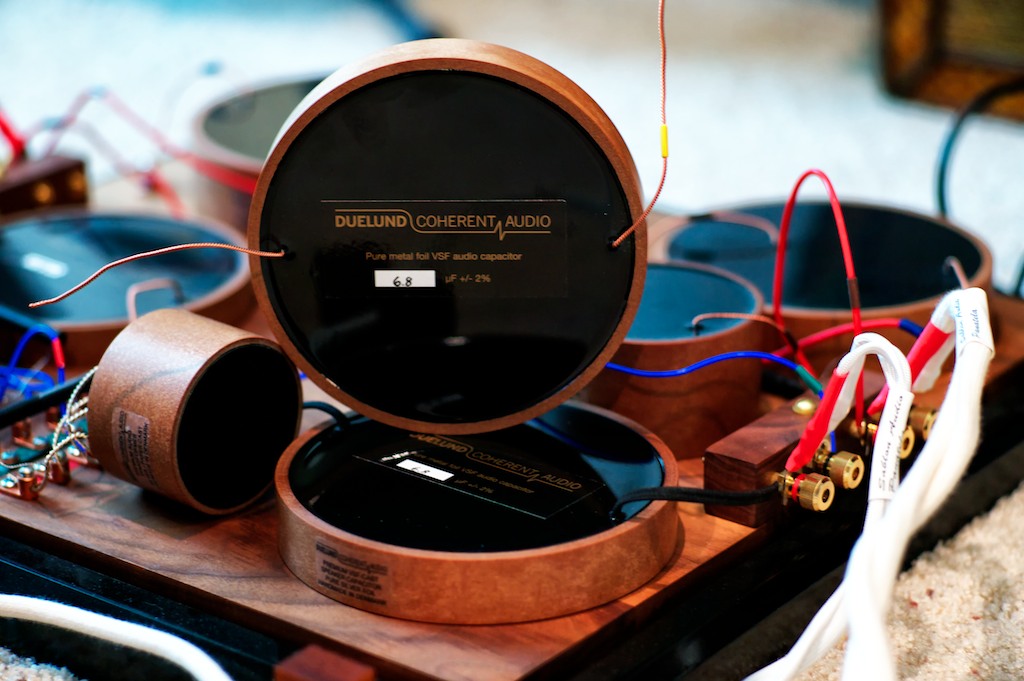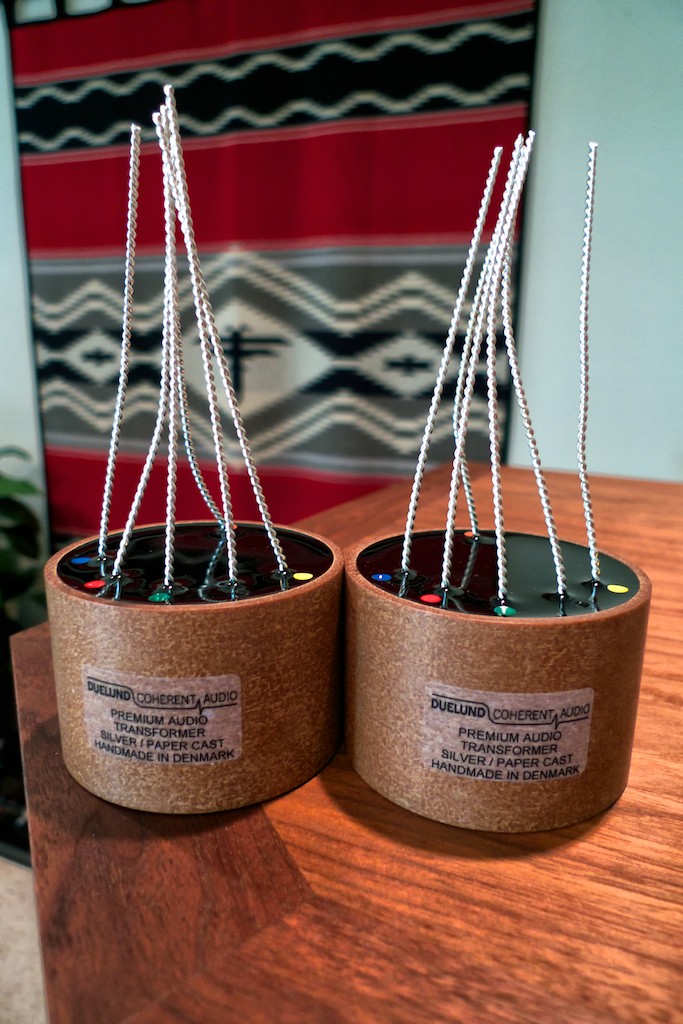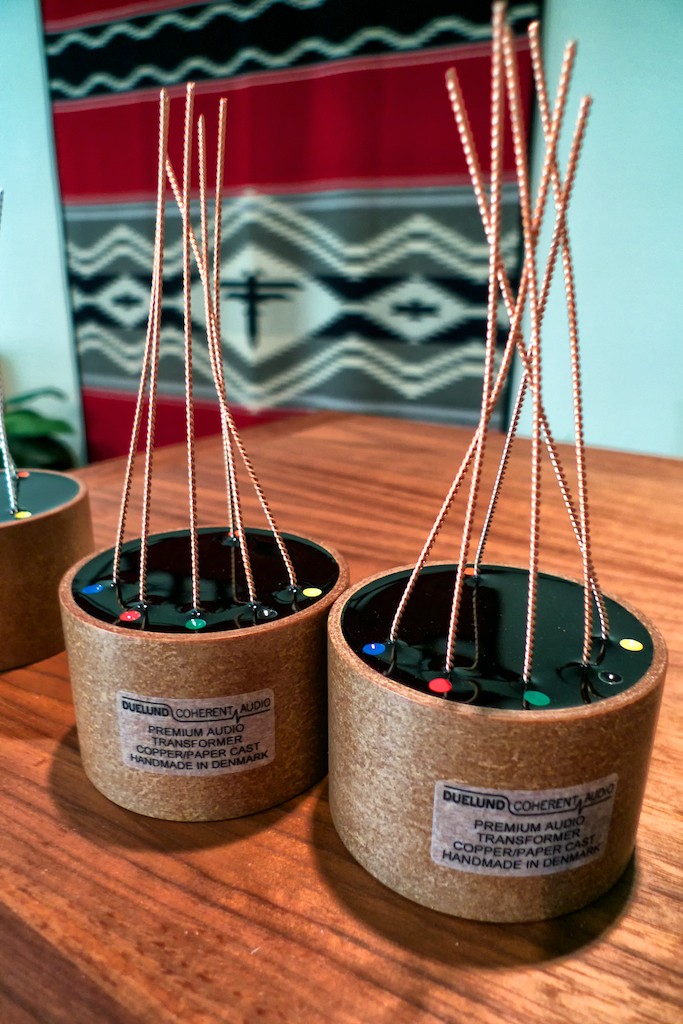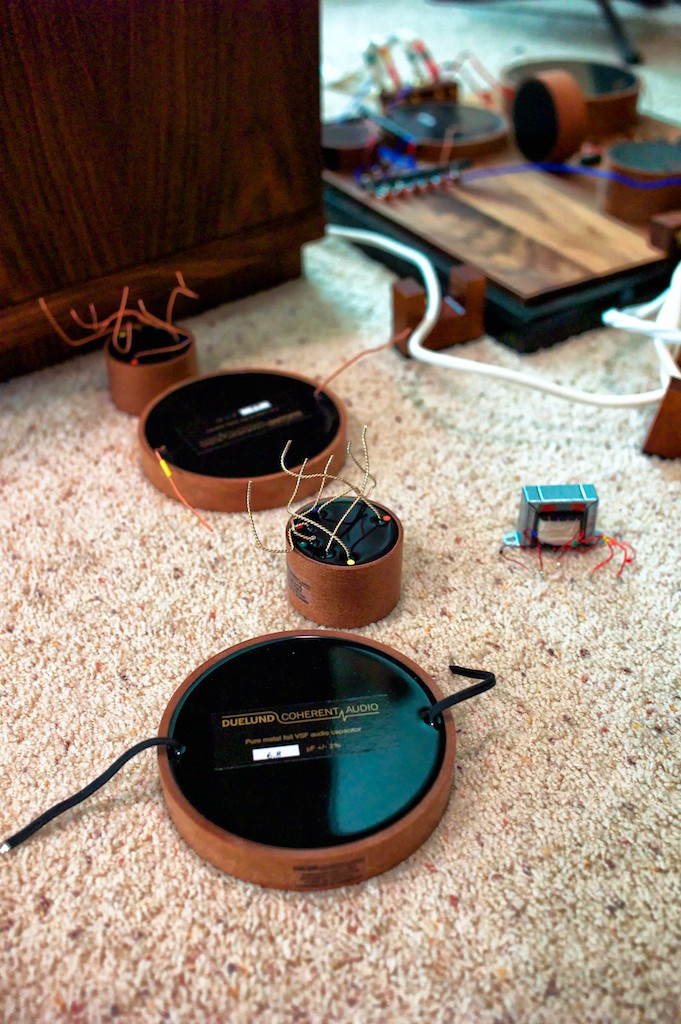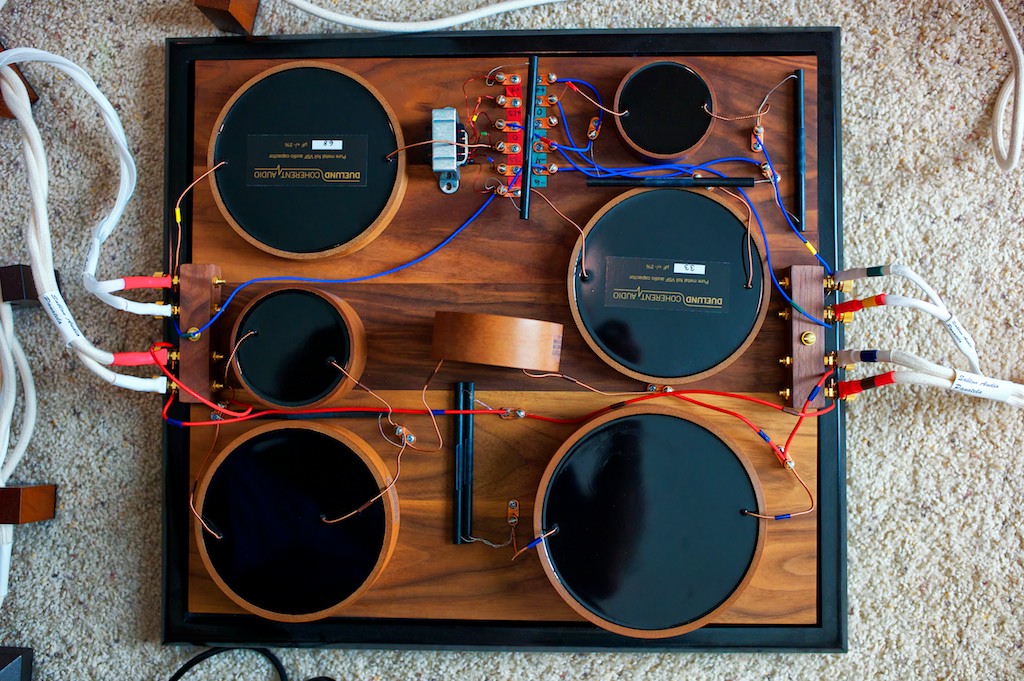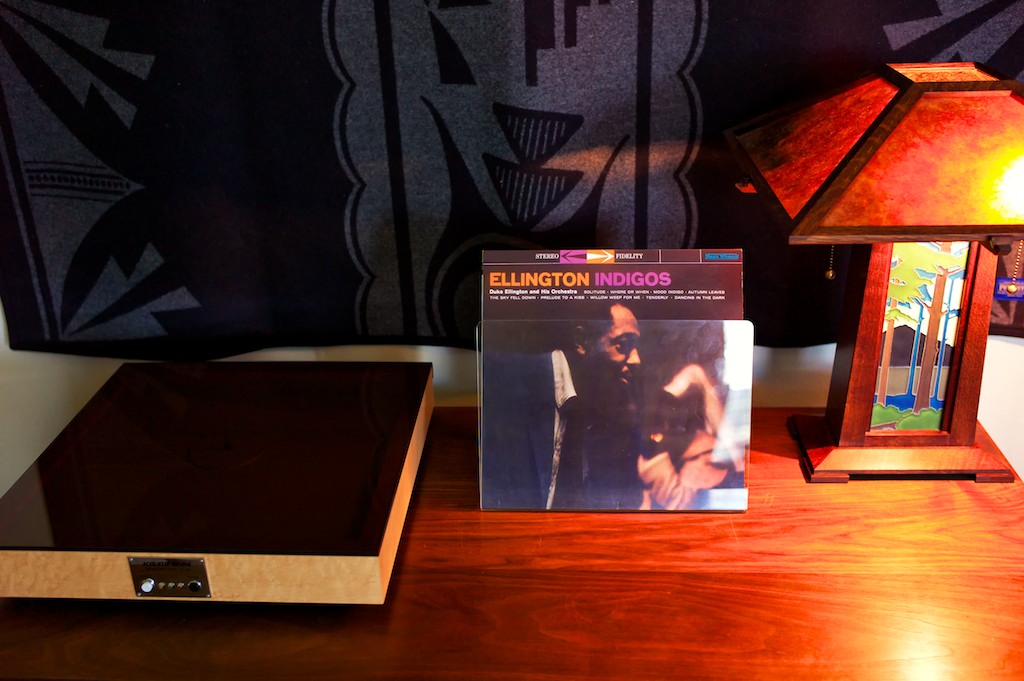I've really been enjoying the charms of all things Duelund, and I am hard at work writing Part 2 of the Duelund-WRSE Project for Positive Feedback Online right now.
The focus of Part 2 of the Duelund-WRSE Project are the 6.8uF Silver Duelund CAST Capacitors for the C1 position of the crossover (shown above), and the long-awaited Duelund CAST Autotransformers in both Silver (above and below) & Copper that Frederik Carøe developed especially for The Project.
Many thanks to Jignesh who has loaned me his custom pair of Copper Duelund CAST Autotransformers that Frederik Carøe made for him, so I could tell you about both the Copper & Silver versions in the article for Positive Feedback Online.
I've written about 9 pages of the introduction and technical sections, and now I'm getting started on the in-depth listening sessions so I can tell you in detail about both the performance of the Silver CAST capacitors & the Silver & Copper CAST autotransformers on the usual audiophile parameters like imaging, soundstage, resolution, soundspace, and even more importantly I think, about their musical prowess on parameters like timbral realism, tone color resolution, melody, harmony, rhythm, dynamics, loudness, and tempo, which make up the fabric of the music itself.
The baseline I'm starting from is the Duelund-WRSE Project external crossover as it was as described in Part 1, with the stock Tannoy autotransformers and the 6.8uF Duelund CAST capacitors in the C1 position. I've been listening informally to the 6.8uF Silver Duelund CAST Capacitors and the Copper & Silver Duelund CAST Autotransformers for a while now, and posting early impressions from time-to-time. This morning I removed them and I'm putting the crossovers back to the Part 1 configuration (above) to reestablish the listening baseline before I start listening comparatively in detail.
The plan is to spend time listening first to the Part 1 configuration for a while to re-familiarize myself with it, then to substitute in the Copper Duelund CAST Autotransformers and listen, and then the Silver CAST Autotransformers and listen, and then the Silver CAST capacitors and listen. I may do a few other permutations just for fun too.
I'll try to add to this post over the weekend to share any insights with you along the way, so check back from time to time for more reporting as I get deeper into the listening sessions.
As always, thank you for stopping by, and from my home to yours, may the music playing bring you joy!
Update 1 - Saturday Evening
I put the Duelund CAST crossover back into the Part 1 article configuration of the stock Tannoy autotransformer and the copper 6.8uF Duelund CAST capacitor in the C1 position (below, upper left) to do a little listening, and I have to say I've really got caught up in the joy of listening to music this afternoon.
Here's some snippets from my listening notes (I'm now on page 16 of the article for Positive Feedback):
"I had been listening to the Silver & Copper Duelund CAST Autotransformers, and the 6.8uF Silver Duelund CAST capacitors, a lot lately, trying to get some time in on them to make sure they’re run-in adequately for the review. Truth is, I thought they sounded great straight out of the box, and they have only gotten better over time.
It was time to put the crossovers back to their Part 1 configuration with the stock Tannoy autotransformers, and the copper 6.8uF Duelund CAST capacitors in the C1 positions, and get some listening time in to re-establish my listening baseline for a comparison between the stock Tannoy autotransformer, the copper Duelund CAST autotransformer, and the silver Duelund CAST autotransformer.
I put my copy of Ellington Indigos on the turntable and let her spin. Indigos has been a long time favorite of mine for the musical magic contained within, and I just never seem to get tired of that incredibly artful music played by the greatest jazz orchestra on planet Earth.
Indigos scored four and a half stars in Downbeat in 1958, where Dom Cerulli called it a “dance set” that emphasized shades of colors, with highlights that included Duke’s piano playing owning ‘Solitude’, Paul Gonsalves tenor sax melody magic in ‘Where or When’, and Shorty Baker’s muted trumpet solo in ‘Mood Indigo’.
Indigos is a lot of fun to listen to with the brass, the percussion, the strings, and of course Duke’s magic piano playing, coming through the mix in mesmerizing musical intensity.
You know what? The Duelund CAST crossover with the 6.8uF Duelund CAST copper capacitor in C1 and the stock Tannoy autotransformer absolutely thrills me on Indigos!
In Part 1 I discussed how struck I was by the tone color resolution of the Duelund CAST external crossovers. Many components can blur, homogenize, bleach, or alter tone colors in ways that diminish the emotional connection to the music, but on Indigos the greater ‘tone color’ resolution of the Duelund CAST crossovers allows the tone color of individual instruments in the orchestra to come alive. With the Ellington orchestra you can hear the timbral / tone color contribution of all the individual instruments, which gives the music a higher level of engagement that is more emotionally gripping and exciting. Once you hear it you’ll be addicted.
When Dom Cerulli said Indigos emphasized shades of colors, you’ll know exactly what he’s talking about with the Duelund CAST crossovers: shades of blue notes (Eb, F#, Bb) added into the major and minor triads, but not just blue notes, there’s blue notes that fade into indigo notes and then into black notes. Ok, I just made up indigo & black notes as terms because I don’t know how Ellington’s orchestra makes the tone color shadings sound the way they do, but if you listen to this record through the Duelund CAST crossover, you’ll feel every shade of blue through indigo, and then feel it fade into a brooding ethereal beautiful blackness in the recording that has an emotional intensity that is shattering – I almost broke down and cried. Really. It is pretty damn amazing.
While you’re thinking about that revelation in tone colors let me tell you about Duke’s piano playing on ‘Solitude’ – he owns it: delicateness, dissonance, percussiveness, colorfulness, rich textures, and beauty. I found myself hanging on every note with his slow and expressive tempo, the creative dynamic & textural contrasts that Duke weaves in. It’s a “Wow!” so be sure to give it a listen.
Now listen to Paul Gonsalves play the melody on his tenor sax in ‘Where or When’. Paul’s timbrally rich and haunting tone playing the melody is achingly beautiful, expressive, and mesmerizing, which I suppose is a roundabout way of saying the Duelund CAST crossover is superb at getting the melody across to the listener, even at slow tempos with a tenor sax.
Finally, let’s listen Shorty Baker’s muted trumpet solo in ‘Mood Indigo’. I’ll bet you’re afraid it’ll take your ears off. Nope. Listen to that rich, robust, tone that Shorty is getting. I’ve been so mesmerized by musical charms that I haven’t said much about sonics, but listen to that huge sense of space around Shorty, and the spread of instruments across the width and depth of the soundstage – it is impressive.
The Duelund CAST external crossover with the stock Tannoy autotransformer is stunning both musically and sonically. If the stock Tannoy autotransformer was all that bad it would really throttle down what the Duelund CAST crossover is capable of, but it doesn’t, it is pretty damn good in its own right. It is befitting a fine loudspeaker like the Westminster or Canterbury, and Tannoy did an impressive job on their autotransformer. With the stock Tannoy autotransformer in the Duelund CAST circuit revelation after musical revelation unfolded before my ears."
Ok, that's it for now.
Next up is the copper Duelund CAST autotransformer compared to the stock Tannoy autotransformer.
The photo below is of the copper Duelund CAST autotransformer in the high-frequency circuit.
More to come.




